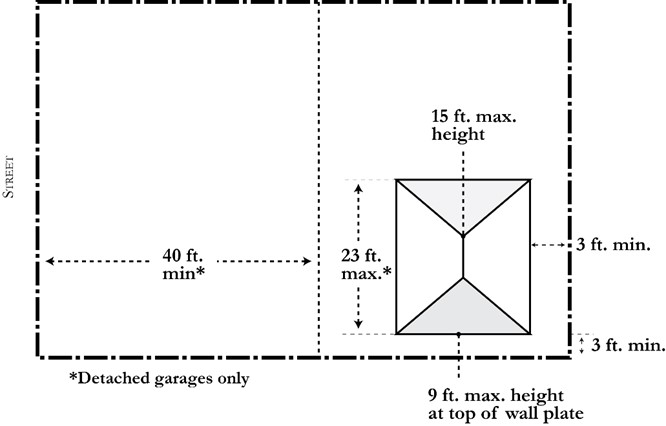Chapter 17.52
ACCESSORY STRUCTURES AND USES Revised 4/23
Sections:
17.52.010 Purpose and applicability.
17.52.020 Accessory structures. Revised 4/23
17.52.010 Purpose and applicability.
This chapter establishes requirements for accessory structures and uses in residential and nonresidential zoning districts. These requirements do not apply to accessory dwelling units, including two-story accessory dwelling units above a detached garage, which are addressed in Chapter 17.74 (Accessory Dwelling Units). (Ord. 1043 § 2 (Att. 2), 2020)
17.52.020 Accessory structures. Revised 4/23
A. All Accessory Structures. The following requirements apply to accessory structures in all zoning districts:
1. Accessory structures shall be clearly incidental and subordinate to the primary structure on the same lot.
2. Accessory structures may not be located on a separate lot from the primary use to which it is incidental and subordinate.
3. A minor design permit is required for garages, sheds and other enclosed buildings with one or more of the following characteristics: an enclosed area of over one hundred twenty square feet, a height of over ten feet, or plumbing fixtures per Section 17.120.030(A).
4. Accessory structures attached to a primary structure are considered a part of the primary structure and shall comply with all standards applicable to the primary structure.
5. Accessory structures may not be designed or used as a bedroom, sleeping area, and/or kitchen, except for accessory dwelling units consistent with Chapter 17.74 (Accessory Dwelling Units) and outdoor kitchens.
6. In the coastal zone, accessory structures shall be sited and designed so that they do not extend into setbacks associated with coastal resource issues (e.g., ESHA setbacks and coastal hazard setbacks). A proposed accessory structure that is located in the coastal zone may require a coastal development permit (CDP) as specified by Chapter 17.44 (Coastal Overlay Zone) and the findings for approval of a CDP as specified in 17.44.130 (Findings for approval).
B. Accessory Structures in Residential Zoning Districts.
1. Development Standards. Accessory structures in residential zoning districts shall comply with the development standards in Table 17.52-1 and in Figure 17.52-1.
|
|
Single-Family Residential Zoning Districts |
Multifamily Residential Zoning Districts |
Additional Standards |
|---|---|---|---|
|
Height, Maximum |
|||
|
15 ft. [1] |
15 ft. |
Section 17.52.020(B)(2) |
|
|
Top of Wall Plate |
9 ft. |
9 ft. |
|
|
Width, Maximum |
23 ft. for detached garages; None for other accessory structures |
None |
|
|
Setbacks, Minimum |
|
Section 17.52.020(B)(3) |
|
|
Front |
40 ft. for detached garages; Same as primary structure for other accessory structures |
Same as primary structure |
|
|
Interior Side |
3 ft. |
3 ft. |
|
|
Street Side |
Same as primary structure |
3 ft. |
|
|
Rear |
3 ft. |
3 ft. |
|
Note:
[1] Accessory structures less than eight feet from a rear or interior side property line may not exceed twelve feet in height.
Figure 17.52-1: Detached Garage Standards in Residential Zoning Districts
2. Height Exception. The planning commission may approve an exception to allow additional height of an accessory structure if necessary to match the architectural style of the existing primary structure.
3. Setback Exceptions. One accessory structure permanently attached to the ground is allowed in required side and rear setback areas if the structure is less than ten feet in height, has one hundred twenty square feet or less of enclosed area, and has no plumbing. One additional accessory structure is allowed in required side and rear setback areas with an administrative permit.
4. Driveway Standards. The placement of detached garages shall allow for the design and location of driveways consistent with Chapter 17.76 (Parking and Loading).
5. Nonconforming Garages. An existing detached garage in a residential single-family zoning district that does not comply with development standards in Table 17.52-1 is legal nonconforming and may be repaired, renovated, or replaced; provided, that the nonconformity is not increased or exacerbated.
6. Yards. An accessory structure may not be located within a front or exterior side yard except as specified in Section 17.48.030(E) (Allowed Encroachment in Setback Areas and Yards).
C. Accessory Structures in Nonresidential Zones. Accessory structures in nonresidential zoning districts are subject to the same development standards (e.g., height and setbacks) as primary structures in the applicable zoning district. Accessory structures should be located to the side or rear of buildings and screened from public view. (Ord. 1057 § 2 (Att. 1), 2022; Ord. 1043 § 2 (Att. 2), 2020)
17.52.030 Accessory uses.
A. Residential Accessory Uses. The following requirements apply to accessory uses in residential zoning districts:
1. Accessory uses shall be located on the same parcel as a residence and shall be clearly incidental and subordinate to the residence.
2. Accessory uses shall not change the character of the residential use. Examples of permitted accessory uses include home occupations and personal property sales (i.e., garage or yard sales).
B. Nonresidential Accessory Uses. The following requirements apply to accessory uses in nonresidential zoning districts:
1. Accessory uses shall be a part of and clearly incidental and subordinate to the primary use to which it relates.
2. Accessory uses shall be located on the same parcel as the primary use to which it is incidental and subordinate, within the structure.
3. Accessory uses shall be customarily associated with the primary use to which it is incidental and subordinate. Examples of common nonresidential accessory uses include ATMs, vending machines, newsstands, and personal service establishments (e.g., child day care, food services) intended to serve employees or customers and that are not visible from public streets.
4. All exterior vending machines require a conditional use permit.
5. Accessory uses may not necessitate an increase in required number of parking spaces. (Ord. 1043 § 2 (Att. 2), 2020)


